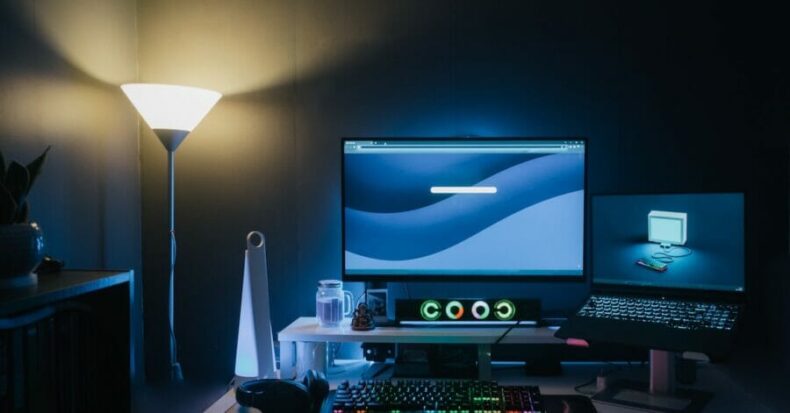Is 17 Inch Laptop Too Big? Advantages and disadvantages Explained

Is 17 inch laptop too big? A laptop is an essential tool that helps us to perform our daily tasks efficiently and effectively. Laptops come in sizes and shapes, ranging from 13 to 18 inches. We tend to think that bigger laptops are better, but there is no perfect size or shape. There are some pros and cons associated with each size.
This article will discuss whether a 17-inch laptop is too big for you and its advantages and disadvantages. Laptops come in different sizes, and the 17-inch model is one of the larger options. Whether a 17-inch laptop is too big depends on various factors, including personal preference, usage, and mobility.
Advantages of a 17-inch Laptop:

Larger Screen:
One of the most significant advantages of a 17-inch laptop is the larger screen size. This can be especially beneficial for users who work simultaneously with multiple windows or open applications, such as graphic designers, video editors, or gamers.
The increased screen real estate allows for a more comfortable viewing experience and can reduce eye strain and fatigue. Additionally, a larger screen can be advantageous for presentations or group work, making it easier for multiple people to view the screen simultaneously.
Better Graphics:
Another advantage of a 17-inch laptop is the potential for improved graphics performance. With a larger screen, there is more room for a dedicated graphics card, which can handle more demanding tasks such as gaming, video editing, or 3D modelling.
This is because a dedicated graphics card has its own dedicated memory and processing power, which can be more powerful than integrated graphics in smaller laptops. A dedicated graphics card can also help to improve overall system performance, as it takes some of the processing load off the CPU.
Improved Keyboard and Touchpad:
A 17-inch laptop typically has more space for a larger keyboard and touchpad, which can provide a more comfortable and efficient typing experience. The larger keyboard can have a more ergonomic layout, with larger keys that are easier to press and better spaced. The touchpad can also be larger, providing more room for gestures and precision movements.
Additionally, a larger laptop often has a full-sized numeric keypad, which can be useful for data entry or accounting work. A larger keyboard and touchpad can make the laptop more user-friendly and productive.
Also Read. Is it Safe to Put Laptop in Backpack? Find Out Here
Disadvantages of a 17-inch Laptop:
Weight and Portability: One of the biggest drawbacks of a 17-inch laptop is its weight. These models tend to be heavier and bulkier, making them less suitable for travel or carrying around regularly.
Battery Life: The larger size and more powerful components of a 17-inch laptop also result in shorter battery life than smaller laptops.
Price: Laptops with 17-inch screens are typically more expensive than their smaller counterparts, which can make them less accessible to budget-conscious consumers.
Who Should Consider a 17-Inch Laptop:

Gamers:
Gamers are one group of people who should consider a 17-inch laptop. This is because a larger screen size allows for a more immersive gaming experience, with better graphics and more detail visible on the screen. A 17-inch laptop can also support more powerful hardware, including high-end graphics cards and faster processors, essential for running demanding games smoothly.
Additionally, a larger screen can make it easier to see the game’s details, making it more comfortable for players to play for extended periods.
Video Editors:
Video editing is another area where a 17-inch laptop can be a good option. Larger screen sizes make it easier to see and edit the video accurately. Additionally, video editing software can be very demanding on a computer’s hardware. A 17-inch laptop can provide more processing power and RAM than smaller laptops, essential for handling large video files and complex editing tasks.
Office Workers:
Office workers are another group of people who should consider a 17-inch laptop. While a larger screen may not be necessary for basic office tasks such as word processing and web browsing, it can benefit those working on large spreadsheets or multiple documents simultaneously.
Additionally, a larger screen can reduce eye strain and fatigue, which can be a significant problem for office workers who spend long hours in front of their computer screens. Finally, a 17-inch laptop can also provide more processing power and memory, which can be useful for running multiple programs simultaneously and handling more demanding tasks such as video conferencing and data analysis.
What is the normal laptop size?
The standard laptop size is called a “clamshell” form factor and usually measures between 13 to 17 inches diagonally across the screen. The exact dimensions of a laptop can vary, but the screen size is the most significant factor determining the device’s overall size and portability.
13-inch laptops are the most portable option, making them a great choice for those who need to work on the go. They are small and lightweight but still large enough to provide a comfortable viewing experience.
14-inch laptops are a good compromise between portability and screen size, offering a balance of both in a compact form factor.
17-inch laptops are the largest size and are often favoured by gamers or creative professionals who need a larger screen for their work. They are less portable but provide a more immersive viewing experience.
It’s important to note that besides screen size, other factors such as battery life, weight, performance, and connectivity options can also play a role in determining the best laptop size for a specific use case.
What laptop size is best for students?
The best laptop size for students depends on several factors, such as their specific needs, preferences, and budget. Here are some popular laptop sizes that are suitable for students and the advantages and disadvantages of each:
13-inch laptops: They are lightweight and portable and offer a good balance of screen size and portability. These are ideal for students who are always on the go and need a laptop that can easily fit in a backpack.
14-inch laptops: They offer a larger screen and more real estate than 13-inch laptops, making them ideal for students who need more screen space for multitasking or for those who value a larger display for viewing and editing documents.
15-inch laptops: They are larger than 14-inch laptops and offer more screen space and improved graphics performance, making them ideal for students who need more screen real estate for video editing, graphic design, or gaming. However, they tend to be bulkier and less portable.
17-inch laptops: They are the largest laptops and offer the most screen space and graphics performance, but they are also the heaviest and least portable. These are best for students who need a large display for intensive tasks but do not mind the added bulk.
Ultimately, the best laptop size for a student will depend on their specific needs and preferences, and it’s recommended to try out different sizes to determine which one is the most comfortable to use.
Which laptop screen size is best for the eyes?

The best laptop screen size for the eyes depends on various factors, such as the individual’s personal preference, intended use, and physical attributes. However, some general guidelines can be followed to minimize eye strain:
Screen Size: A screen size between 14 to 15.6 inches is recommended for most people, as it provides a comfortable viewing experience without being too small or too large.
Screen Resolution: A high-resolution screen (1920×1080 pixels or higher) can reduce eye strain by displaying finer details and reducing the need for zooming in and out.
Display Type: An IPS (In-Plane Switching) display is recommended as it offers better viewing angles and colour accuracy and reduces glare compared to other display technologies.
Text Size: A larger text size makes it easier to read, which reduces eye strain and fatigue.
It’s also important to note that frequent breaks, reducing screen brightness, and adjusting screen position can help reduce eye strain. In conclusion, the best eye screen size depends on the individual and their needs. Still, a laptop with a screen size between 14-15.6 inches, a high resolution, an IPS display, and a larger text size can provide a comfortable and eye-friendly viewing experience.
Conclusion:
Whether a 17-inch laptop is too big depends on various factors, including personal preference, usage, and mobility. While they have advantages like a larger screen, better graphics, and a more comfortable keyboard, they also have disadvantages, such as weight, short battery life, and a higher price point. Ultimately, the decision to go with a 17-inch laptop will depend on your specific needs and priorities.
FAQs.
Is 17 inch Big For a laptop?
17 inches is common for laptops; it’s not considered small, but not extremely big either.
Is it worth getting a 17-inch laptop?
It depends on personal preference and intended use. 17-inch laptops can offer more screen real estate and better performance than smaller ones but can be bulkier and heavier.
Is 17 gaming laptops too big?
It depends on personal preference. Some people may find 17-inch gaming laptops too big, while others may find them perfect.
What is the most popular size laptop?
The most popular laptop size is around 14 inches, as it offers a good balance of portability and screen size.



